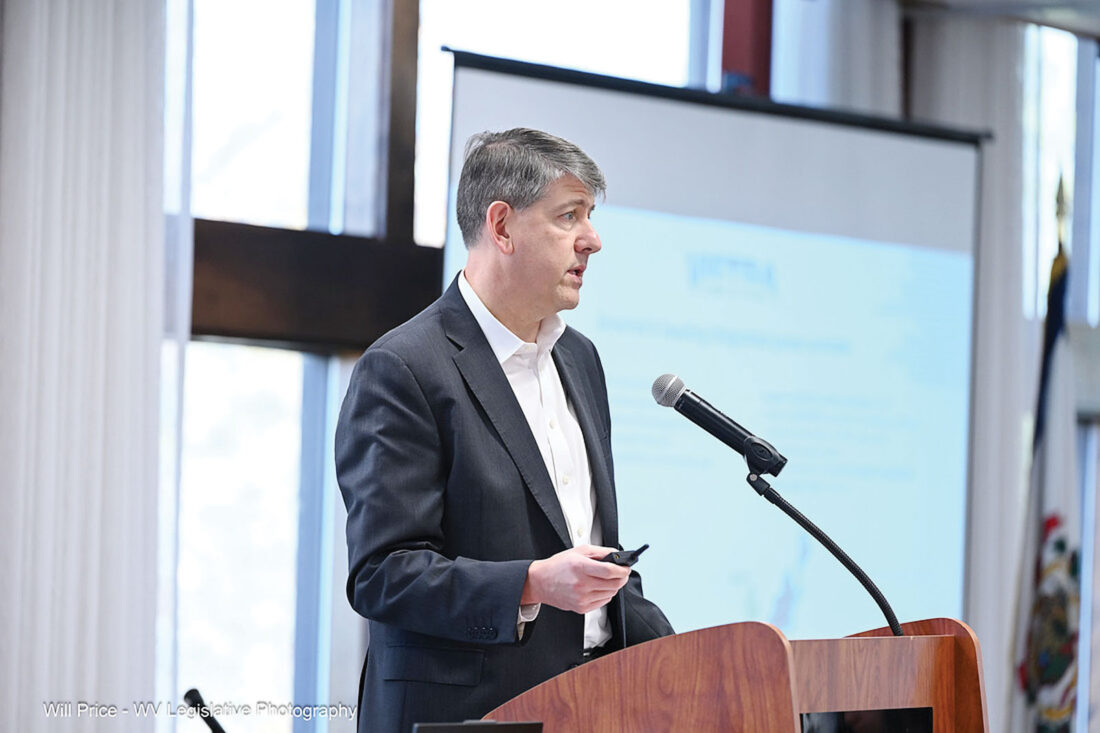Lawmakers hear arguments for, against a deregulated electric market

Vistra Corp. Senior Vice President Arnie Quinn briefs lawmakers on allowing for regulation for commercial and industrial electricity customers to allow them to build out their own electricity generation. (Photo Courtesy/WV Legislative Photography)
CHARLESTON — With the West Virginia Legislature expected to tackle electric utility issues during the next 60-day regular session in January, lawmakers received a crash course on how the electric utility market works.
Members of the Joint Committee on Energy and Public Works received presentations Monday on the differences between a regulated and deregulated electric utility market during November legislative interim meetings at Pipestem Resort State Park in Summers County.
Arnie Quinn is the senior vice president of Regulatory Policy for Texas-based Vistra Corp., a retail electricity and power generation company.
West Virginia is one of 12 states and Washington, D.C., which are part of PJM Interconnection, a regional electric transmission organization that operates a competitive wholesale electricity market in the northeast.
Quinn’s presentation focused on what he called “surgical” retail choice for large commercial and industrial electrical customers, allowing commercial and industrial operations to own and operate their own power plants, allowing those commercial and industrial operations to also sell that power.
According to Quinn, retail choice would allow only large commercial and industrial customers to have the option to shop for an electricity provider, such as Vistra. The retail choice plan would allow new competitive electricity generation to be sited in West Virginia, potentially backed by long-term contracts with large customers.
Vistra has plant operations in Ohio, Pennsylvania and Virginia, as well as a retail operation in Maryland. In West Virginia, Vistra already owns a power plant, the Luminant 388-megawatt natural gas plant in Pleasants County that provides electricity to retail customers in the PJM market.
Quinn argued that retail choice would lower costs for commercial and industrial customers, enhance economic development by making West Virginia competitive with neighboring states, and stimulate new generation investment from the private sector. Vistra’s proposal would be optional for large customers, would not change the regulated “wires” part of the business, and would not require utilities to divest their existing generation assets.
“Expanding… retail choice to commercial and industrial customers offers for West Virginia a very surgical change that would allow — but not require — commercial and industrial customers to have the choice of what retail supplier serves them,” Quinn said. “It can lower costs for those customers, give them access to a lower price, allow them to compete on an even footing with their competitors in states around West Virginia, and allow new businesses to have a choice as they decide whether to enter West Virginia.”
According to Quinn, West Virginia’s industrial electricity prices have risen 86% since 2008, compared to 15% in Ohio with a restructured market, with electricity prices across all sectors in West Virginia increasing by 97% in the same period, second only to California.
Within the PJM footprint, 70% of the approximately 80 gigawatts of generation built since 2000 has been by private, competitive investors. However, West Virginia has seen its generation capacity increase by only 4% in this period, lagging significantly behind Pennsylvania (32%) and Ohio (26%).
Quinn said that creating a retail choice program in West Virginia would allow the state to meet the goals laid out in September by Gov. Patrick Morrisey for his 50 by 50 initiative, aimed at increasing base load electric generating capacity in state from 16 gigawatts to 50 gigawatts by 2050 to meet the growing demands being placed on the nation’s electrical grid by data centers.
“I know that the governor has a goal for 50 gigawatts by 2050. In our view, competitive generation is the very best way to get new generation,” Quinn said. “As West Virginia tries to achieve this 50 by 50 goal, doing it only with the electric utilities would require the customers…to kind of bear the risk and the cost if that generation isn’t needed.”
Quinn also discussed a law passed by the Legislature earlier this year — House Bill 2014, the Power Generation and Consumption Act. HB 2014 would streamline development of data center and microgrid projects, offer regulatory exemptions within designated microgrid districts, establish a special valuation for property taxes and a new tax distribution framework for high-impact data centers and create a fund for electric grid stabilization.
“I think the state did a great first step with the microgrid law from last session,” Quinn said. “But I know as we’re talking to customers out there — new data center customers, new large load customers — the willingness to enter into a state where they have a choice of who will serve them has been a very attractive opportunity.”
Brad Viator, a board member with Power for Tomorrow, a non-profit that advocates for maintaining regulated electrical utility markets, provided a counterpoint to Quinn’s perspective. Viator advocated for the preservation and support of West Virginia’s regulated, vertically integrated utility model.
Viator argued that a regulated model such as West Virginia’s as regulated by the Public Service Commission, provides less price volatility, allowing state regulators to decide what generation gets built and how costs are allocated, allowing for long-term strategic planning to meet state goals.
“Everybody thinks the grass is greener on the other side,” Viator said. “If you are in a deregulated state, you think deregulation sucks. If you are in a vertically integrated state, you think vertical integration sucks because you know who the bad guys are that are sending you those big bills.
“In a vertically integrated environment, you control your own destiny,” Viator continued. “You decide what gets built. You decide how those costs get divided. That’s your sort of responsibility. When you deregulate, you outsource the development of electric generation to the free market and sometimes it (doesn’t) show up.”





